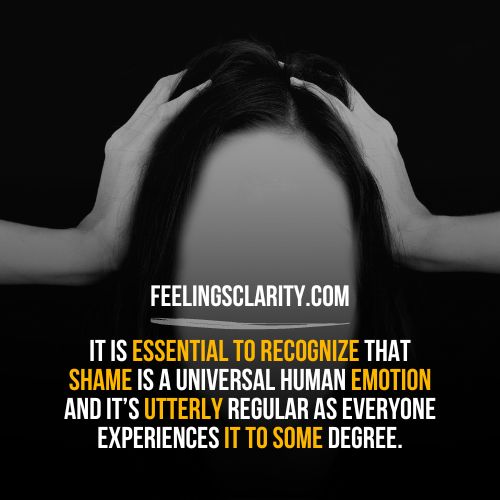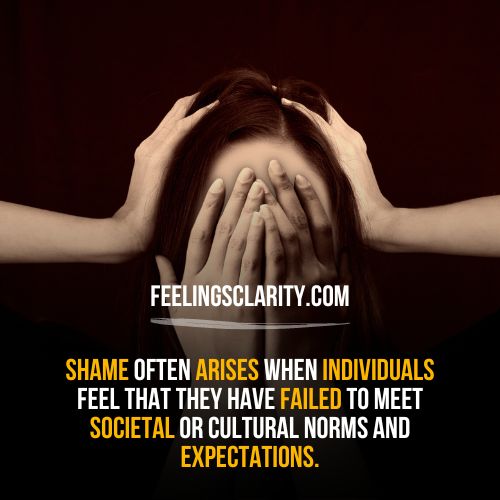What is shame? It’s a powerful emotion that has deep roots in human psychology. It is a complex emotional experience that can be triggered by different situations, both internal and external. Shame often emerges when we have fallen short of personal standards.
In this article, we will explore what is shame and its relationship with various emotions.

Jump to a Specific Section
What is Shame?
Shame can be defined as a deep sense of inadequacy or unworthiness, often accompanied by the belief that one’s flaws or mistakes make one fundamentally defective as a person.
It differs from guilt which focuses on a specific action or behavior, while shame targets an individual’s core identity. The mechanism of shame involves an internal evaluation of self, comparing one’s actions or characteristics with societal norms or personal values, resulting in negative self-judgment.
HOW TO SELF IDENTIFY THE SHAME
Self-evaluation of shame can be a challenging but important process for personal growth and emotional well-being.When engaging in self-evaluation related to shame, its essential to approach the process with understanding.
It is essential to recognize that shame is a universal human emotion and it’s completely normal as everyone experiences it to some degree.
Here are some steps for a constructive self-evaluation of shame:
- First of all, begin by identifying situations or experiences that trigger the feeling of shame. These triggers could be related to past mistakes, constant failures, moments of vulnerability or moments where you believe you did not meet your own expectations.
2. Once you have identified your triggers, ask yourself what specific thoughts or beliefs emerge when you experience shame.
For example, do you believe you are unworthy of love or respect because of your perceived shortcomings?
- Reflect on how shame affects your thoughts, emotions, and behaviors.
- Does shame lead to self-criticism, self-isolation, or fear of being judged? By understanding this, you can see how shame influences your life.
- Be gentle with yourself as you explore these emotions. Remember that shame is a natural part of human beings and everyone experiences it at some point. Treat yourself with kindness.
- Shift your focus from thinking about past mistakes to a mindset of growth and learning.
- Embrace the idea that setbacks and failures are opportunities for learning and personal development.
Remember that self-evaluation of shame is a process that takes time and patience. It’s okay to take small steps and seek support as needed.By working on understanding and addressing shame in a compassionate manner, you can pave the way for a healthier relationship with yourself and others.
Types Of Shame
Robert Karen is a psychoanalyst and author known for his work on attachment theory and interpersonal relationships.
In his book, “Shame: The Power of Caring”, Robert Karen describes two primary types of shame.
1. TOXIC SHAME:
Toxic shame is a deeply ingrained sense of worthlessness and inadequacy that an individual feels at their core.
It often originates from early experiences of neglect, emotional abuse, or inconsistent caregiving during childhood. When children do not receive adequate validation from their primary caregivers, they may internalize that they are fundamentally flawed or unlovable.
Toxic shame can persist into adulthood and significantly influence an individual’s self-esteem, self-worth, and overall sense of identity. People with toxic shame may be highly self-critic, avoid intimacy, and struggle with a chronic fear of rejection.
2. NARCISSISTIC SHAME:
Narcissistic shame, on the other hand, refers to the intense fear of being exposed as inadequate or imperfect.
It is associated with a fragile sense of self-esteem and self-importance. People experiencing narcissistic shame often build a defensive façade to protect themselves from feelings of unworthiness.
They may develop a grandiose self-image or engage themselves in seeking validation from others. This type of shame is common in individuals with narcissistic personality traits, where they try to maintain the image of superiority to shield themselves from underlying feelings of shame.
RELATIONSHIP OF SHAME WITH OTHER EMOTIONS
Shame is a complex emotion that often interacts with and influences various other emotions.Its relationship with different emotions can have significant implications for an individual’s psychological well-being and behavior.
Let’s explore some of the primary relationships between shame and other emotions.
1. SHAME AND GUILT:
According to cultural anthropologist Ruth Benedict, shame arises from a violation of cultural or social values while guilt feelings arise from violations of one’s internal values (Wikipedia).
Guilt and shame are closely related but they differ in focus and impact.
Guilt is typically associated with feeling bad about a specific action or behavior, whereas shame is directed at the self, involving a sense of unworthiness or defectiveness. Guilt can lead to constructive behaviors, such as seeking forgiveness or making amends, while shame may be more likely to result in self-punishing or avoidant behaviors.
2. SHAME AND EMBARRASSMENT:
Shame and embarrassment share similarities, especially in social contexts. Both emotions arise from concerns about how others perceive us.
Embarrassment is generally tied to a specific situation, while shame can be more pervasive and related to one’s overall self-concept.
3. SHAME AND FEAR:
Shame is often intertwined with fear and anxiety. The fear of being judged, rejected, or exposed as flawed can trigger the feeling of shame. Conversely, the fear of shame can lead to increased anxiety and fear about facing similar situations in the future.
4. SHAME AND ANGER:
Shame can also be connected to anger. When individuals feel vulnerable due to shame, they may resort to anger as a defense mechanism to protect themselves from further emotional pain or perceived threats.
In some cases, anger can be a way of projecting shame onto others.
5. SHAME AND ENVY:
Envy can be linked to shame when individuals compare themselves to others and feel inferior. This comparison may lead to feelings of shame for not possessing the same attributes, achievements, or possessions as the person they envy.
6. SHAME AND EMPATHY:
Empathy can play a transformative role in dealing with shame. When others offer understanding and empathy, it can create a sense of connection and reduce feelings of isolation associated with shame.
7. SHAME AND SELF-COMPASSION:
Self-compassion is the ability to treat oneself with kindness and understanding. It can counteract the negative impact of shame by helping individuals recognize their common humanity and inherent worth, even in the face of imperfections.
8. SHAME AND VULNERABILITY:
Shame can be closely connected to vulnerability. Experiencing shame may make individuals reluctant to be vulnerable in their interactions with others, fearing potential rejection or judgement.
9. SHAME AND DEPRESSION:
Shame is often associated with depression. The overwhelming feelings of inadequacy and unworthiness that accompany shame can contribute to the development of depressive symptoms.
SOCIAL ASPECTS OF SHAME
Shame is a social emotion with profound implications for interpersonal relationships and societal dynamics. It is deeply connected to how individuals perceive themselves in the eyes of others and how they believe others perceive them.
Here are some of the key social aspects of shame:
1. SOCIAL NORMS AND EXPECTATIONS
Shame often arises when individuals feel that they have failed to meet societal or cultural norms and expectations.
These norms can encompass various aspects of life, such as appearance, behavior, achievements, and social status. When someone believes they fall short of these standards, they may experience shame as a result of social disapproval.
2. SOCIAL COMPARISON
Social comparison plays a significant role in shame. People tend to compare themselves to others to evaluate their own worth and abilities. When individuals perceive themselves as inferior compared to others, it can lead to feelings of shame and negative self-image.
3. FEAR OF REJECTION AND JUDGEMENT
Shame is closely tied to the fear of rejection and judgement by others.
The fear of being exposed as flawed or unworthy can drive individuals to hide aspects of themselves, leading to a lack of authenticity in social interactions.
4. BULLYING AND HUMILIATION
Public humiliation and bullying are powerful triggers of shame. Experiencing these negative social behaviors can lead to deep-seated shame and a sense of powerlessness.
5. SOCIAL CONSTRUCT OF MASCULINITY AND FEMININITY
Social constructs of masculinity and femininity can contribute to shame when individuals feel they do not conform to these norms. For example, men may experience shame for showing vulnerability or emotions, while women may feel ashamed if they don’t fit certain beauty standards.
WHAT GOOD DOES SHAME DO?
Shame, like any emotion, serves a purpose and has some potentially beneficial aspects.
It is important to acknowledge that while shame can be uncomfortable and challenging to experience, it can also play a role in shaping behavior and promoting social cohesion in certain contexts.
Here are some potential benefits of shame:
1. MORAL DEVELOPMENT:
Feeling shame can contribute to the development of an individual’s moral compass. When someone experiences shame for violating their own ethical or moral principles, it can lead to introspection and a desire to align their actions with values.
2. LEARNING FROM MISTAKES:
Shame can prompt individuals to learn from their mistakes and take responsibility for their actions. It can be a motivating factor for personal growth and positive change.
3. EMPATHY AND CONNECTIONS:
Experiencing shame can enhance empathy and compassion for others who may be going through similar struggles.
This shared emotional experience can foster a sense of connection and understanding.
By understanding the multifaceted nature of shame and its impact on individuals and communities, we can work towards creating a more empathetic and accepting world, where people feel valued, understood, and empowered to grow and flourish despite their imperfections.

FAQ’s
1. What is shame?
Shame is a complex and intense emotion that stems from feelings of inadequacy, unworthiness, or a sense of being fundamentally flawed or defective. It often involves a negative evaluation of oneself based on real or perceived shortcomings.
2. How is shame different from guilt?
While both shame and guilt involve negative emotions about oneself, guilt is typically focused on a specific action or behavior that one regrets. Shame, on the other hand, is more about a global negative self-assessment, often tied to one’s identity or core sense of self.
3. What causes shame?
Shame can stem from a variety of sources, such as childhood experiences, societal expectations, trauma, rejection, failure, or even unrealistic personal standards. It can be triggered by both external events and internal thoughts.
4. How does shame affect mental health?
Experiencing chronic or intense shame can have detrimental effects on mental health. It may lead to low self-esteem, depression, anxiety, perfectionism, and even contribute to issues like self-harm or suicidal thoughts.
5. Is shame always bad?
While shame can be uncomfortable and distressing, it can also serve as a social and moral guide, helping individuals conform to societal norms and values. However, excessive or unmanageable shame can be harmful.
6. How can I cope with shame?
Coping with shame involves recognizing and acknowledging it, challenging negative self-perceptions, practicing self-compassion, seeking support from friends, family, or professionals, and reframing negative thoughts.
7. Can shame be overcome?
Yes, it’s possible to overcome shame through therapy, self-awareness, and personal growth. Developing a healthy self-concept, learning from mistakes, and fostering self-acceptance are important steps towards overcoming shame.
8. What role does shame play in relationships?
Shame can impact relationships negatively by creating barriers to intimacy and communication. People may hide their true selves or fear vulnerability due to a fear of being judged or rejected.
9. Is shame culturally influenced?
Yes, the experience and expression of shame can be influenced by cultural norms and values. Some cultures might emphasize collective shame, where an individual’s actions reflect on their entire community, while others might focus more on individual shame.
10. When should I seek professional help for shame-related issues?
If feelings of shame are causing significant distress, interfering with daily functioning, or contributing to mental health concerns, it’s a good idea to seek help from a therapist or mental health professional who can provide guidance and support.